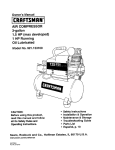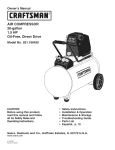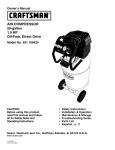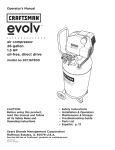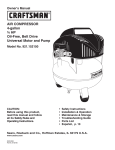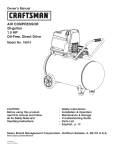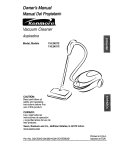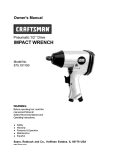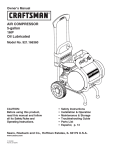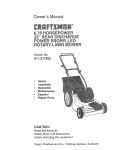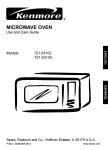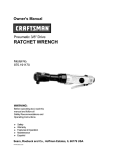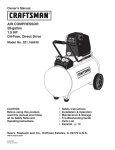Download COMPANION 921.153501 Owner`s manual
Transcript
Owner's Manual Comp,,anion AIR COMPRESSOR 7-gallon 1.5 HP Oil Free Model No. 921.153501 CAUTION: Before using this product, read this manual and follow all its Safety Rules and Operating Instructions. • • • • • Safety Instructions Installation & Operation Maintenance & Storage Troubleshooting Guide Parts List • Espa_ol, Sears, Roebuck www.sears.com ?j'&t2005 Part No E101265 and Co., Hoffman Estates, p. 12 IL 60179 U.S.A. TABLE OF CONTENTS Page Warranty ............................................................... 2 Safety Symbols .......................................................... 3 Important Safety Instructions & Guidelines ..................................... 3 Specifications 4 Glossary ........................................................... ............................................................... 5 Duty Cycle .............................................................. 5 Parts & Features ......................................................... 5 InstalLation & Assembly .................................................... 6 Operating Procedures ..................................................... 7 Maintenance 7 Storage ............................................................ ............................................................... 7 Troubleshooting Guide ..................................................... 8 Notes 9 ................................................................. Exploded View ........................................................... 10 Parts List ............................................................... 11 EspaSol 12 ............................................................... ONE YEAR FULL WARRANTY ON COMPANION AIR COMPRESSOR If this Companion Air Compressor fails due to manufacturer's defects in material or workmanship within one year of the date of purchase, RETURN IT TO THE NEAREST SEARS STORE IN THE UNITED STATES and it will be replaced free of charge. This warranty gives you specific legal rights and you may also have other rights which vary from state to state. Sears, Roebuck and Co., Dept. 817WA, Hoffman Estates, IL 60179 2 Safety Symbols The information listed below should be read and understood by the operator. This information is given to protect the user while operating and storing the air compressor, We utilize the symbols below to allow the reader to recognize important information about their safety. Indicates an imminently hazardous situation which, if not avoided, will result in death or serious injury. Indicates a potentially hazardous situation which, avoided, may result in minor or moderate injury. Indicates a potentially hazardous situation which, if not avoided, could result in death or serious injury When used without the safety alert symbol indicates a potentially hazardous situation which, if not avoided, may result in property damage. if not Important Safety Instructions and Guidelines • Save all instructions Improper operation or maintenance of this product could result in serious injury and/or property damage. Read and understand all of the warninc s and safety instructions provided before using this equipment. The air compressor must be operated on a dedicated 15 amp circuit. If the circuit does not have 15 free amps available, a larger circuit must be used. Always use more air hose before utilizing extension cords. All extension cords used must be 12 gauge with a maximum length of 25 ft. The circuit fuse type must be a time delay. Low voltage could cause damage to the motor. Risk of Moving Parts I Risk of Burns 1 Risk of Falling If the air compressor is in operation, all guards and covers should be attached or installed correctly. If any guard or cover has been damaged, do not operate the equipment until the proper personnel has correctly repaired the equipment. The power cord should be free from any moving parts, twisting and/or crimping while in use and while in storage. There are surfaces on your air compressor that while in operation and thereafter can cause serious burns if touched. The equipment should be allowed time to cool before any maintenance is attempted. Items such as the compressor pump and the outlet tube are normally hot during and after operation. Operation of the air compressor should always be in a position that is stable. Never use the air compressor on a rooftop or elevated position that could allow the unit to fall or be tipped over. Use additional air hose for elevated jobs. Important Safety Instructions & Guidelines Risk from Flying Objects Always wear ANSI Z87,1 approved safety glasses with side shields when the air compressor is in use. Turn off the air compressor and drain the air tank before performing any type of maintenance or disassembly of the hoses or fittings. Never point any nozzle or sprayer toward any part of the body or at other peopfe or animals. Risk to Breathing Avoid using the air compressor in confined areas. Always have adequate space (12 inches) on all sides of the air compressor. Also keep children, pets, and others out of the area of operation. This air compressor does not provide breathable air for anyone or any auxiliary breathing device. Spraying material will always need to be in another area away from the air compressor to not allow intake air to damage the air compressor filter. Risk of Electrical Shock Never utilize the air compressor in the rain or wet conditions. Any electrical issues or repairs should be performed by authorized personnel such as an electrician and should comply with all national and local electrical codes. The air compressor should also have the proper three prong grounding plug, correct voltage, and adequate fuse protection. Risk of Explosion or Fire Never operate the compressor near combustible materials, gasoline or solvent vapors. If spraying flammable materials, locate the air compressor at least 20 feet away from the spray area. Never operate the air compressor indoors or in a confined area. Risk of Bursting Drain the air compressor tank daily or after each use. if the tank develops a leak, replace the air compressor. Never use the air compressor after a leak has been found or try to L j,, mca ionsot ter dthe co rooto s which control the tank pressure Spe iflcations Pump ............................. Motor Induction ..................... Bore .............................. Stroke ............................ Oil-free direct drive 1.5 HP 2.48" 0.86" Voltage Single Phase ................ Minimum Circuit Requirement .......... Air Tank Capacity .................... Cut-in Pressure ..................... Cut-out Pressure .................... SCFM @ 90 PSI .................... SCFM @ 40 PSI .................... 120 VAC 15 Amps 7 Gallons 105 PSI 135 PSI 3.0 5.0 or any other function. Glossary CFM: Cubic feet per minute. SCFM: Standard cubic feet per minute; a unit of measure for air delivery. PSlG: Pounds per square inch gauge; a unit of measure for pressure. ASME: American Society of Mechanical Engineers. California Code: Unit may comply with California Code Cut-Out Pressure: The point at which the motor stops when the tank has reached maximum air pressure. Code Certification: Products that bear one or more of the following marks: UL, ETL or CSA, have been evaluated by OSHA-certified independent safety laboratories and meet the applicable Underwriters Laboratories Standards for Safety. 462 (!) (2)/(M) (2). Cut-In Pressure: The air compressor will automatically start to refill the tank when the pressure drops below the prescribed minimum. Duty Cycle This is a 50% duty cycle air compressor. Do not operate the air compressor more than 30 minutes of one hour. Doing so could damage the air compressor, Parts & Features See figures below for reference. Drain Valve: Used to drain condensation from the air tank, Located at bottom of tank (see parts diagram). MotorThermat Overload: The motor has a manual thermal overload protector, if the motor overheats, this protector will shut off the motor. To restart the motor turn off the pressure switch and then turn the switch back to the "On" position. Quick Connect: Offers a quick release feature for attaching and removing the air hose. Pressure Switch: This controls the power to the motor and also the cut-in/cut-out pressure settings. This switch serves as the Auto-On/Off positions for the unit, Air Intake Filter: Provides clean air to the pump and must always be kept free of debris. Check on a daily basis or before each use. Air Compressor Pump: Oil free direct driven pump that compresses air which is distributed to the tank (not shown). Pressure Relief Valve: The pressure relief valve, located on the side of the pressure switch, is designed to automatically release compressed air when the air compressor reaches cut-out pressure. The released air should only escape momentarily and the valve should then close. Tank Safety Valve: Used to allow excess tank pressure to escape into the atmosphere. This valve should only open when the tank pressure is above the maximum rated pressure, Regulator Pressure Gauge: Indicates the outgoing air pressure to the tool and is controlled by the regulator. Tank Pressure Gauge: Indicates the reserve air pressure in the tank. Regulator: The air pressure coming from the air tank is controlled by the regulator. To increase the pressure turn the knob clockwise and to decrease the pressure turn the knob counterclockwise. Check Valve: When the pump is not in operation the valve closes to retain air pressure inside the tank. An internal component. Regulator Pressure Gauge \\\ _ \ "Tank I // \ Regulator i Safety Valve '\ Filter J Pressure Relief Valve Quick Connect / j j_. Check Valve Installation & Assembly The air compressor should be turned off and unplugged from the power source before any installation and assembly is performed as well as the air bled from the tank and the unit allowed time to cool. Personal injuries could occur from moving parts, electrical sources, compressed air or hot surfaces. If unsure of assembly instructions or you experience difficulty in the assembly please call your local service department for further instruction. To Install the Air Intake Filter Remove the assembly from the poly bag and thread the filter assembly onto the head of the compressor as shown. \\ Air IntekeFilter Location of the Air Compressor The air compressor should always be located in a clean, dry, and well ventilated environment. The unit should have at minimum, 12 inches of space on each side. The air intake filter should be free of any debris or obstructions. Check the air filter on a daily basis to be sure it is clean and in working order. Grounding Instructions This product must be grounded. In the event of an electrical short circuit, grounding reduces the risk of electric shock by providing an escape route for the electric current. This product is equipped with a cord having a grounding wire with an appropriate grounding plug. (See the figure below.) The plug must be plugged into an outlet that is properly installed and grounded in accordance with all local codes and ordinances. Check with a qualified electrician or service personnel if these instructions are not completely understood or if in doubt as to whether the tool is properly grounded. ['_-_. Plug Installing i_ _ Wheels The wheels and handle do not provide adequate clearance, stability or support for pulling the unit up and down stairs or steps. The unit must be lifted or pushed up a ramp. It may be necessary to brace or support one end of the air compressor when attaching the wheels, because it will have a tendency to tip. Items Needed For Assembly • 19mm or adjustable wrench for shoulder bolt • 17mm or adjustable wrench for nylon lock nut Install one shoulder bolt, washer, and one nut for each wheel using bolt holes provided in the wheel bracket. The shoulder bolt will install from the outside of the wheel through the top hole in the wheel bracket. Tighten securely with the washer and nut positioned on the inside of the wheel bracket. Lubrication and Oil This compressor requires no lubrication or oiling. No break in procedure is required by the user. This product is factory tested to ensure proper operation and performance. Grounding Pin ... Ii Improper installation of the grounding plug will result in a risk of electric shock. If repair or replacement of the cord or plug is necessary, do not connect the grounding wire to either flat blade terminals. Check with a qualified electrician or serviceman if the grounding instructions are not completely understood, or if in doubt as to whether the product is properly grounded. Do not modify the plug provided; if it will not fit the outlet, have the proper outlet installed by a qualified electrician. This product is for use on a circuit having a nominal rating of 120 volts end is factory-equipped with a specific electric cord and plug to permit connection to a proper electric circuit. Make sure that the product is connected to an outlet having the same configuration as the plug. No adapter should be used with this product. If the product must be reconnected for use on a different type of electric circuit, qualified service personnel should make the reconnection. Extension Cords Use only a 3-wire extension cord that has a 3-blade grounding plug, and a 3-slot receptacle that will accept the plug on the product. Make sure your extension cord is in good condition. When using an extension cord, be sure to use one heavy enough to carry the current your product will draw. Cords must not exceed 25 feet and No. 12 AWG size must be used. An undersized cord will cause a drop in line voltage resulting in loss of power and overheating, Operating Procedures Maintenance Daily Start-Up Procedures 1. Set the Auto-On/Off lever to the Off position. 2. Check the air compressor visually for any damage or obstruction. 3. Close the drain valve. 4. Connect the air hose to the quick connect socket on the regulator assembly by inserting the quick connect plug on the air hose into the quick connect socket. The quick connect socket collar will snap forward and lock the plug into place providing an air tight seal between the socket and plug.To release the air hose push the collar back on the quick connect socket. 5. Plug the power cord into the proper receptacle. 6. Turn the Auto-On/Off lever to the On-Auto position and the compressor will start and build air pressure in the tank to cut-out pressure and then shut off automatically. 7. Adjust the regulator to a PSI setting that is needed for your application and be sure it is within the safety standards required to pedorm the task. If using a pneumatic tool, the manufacturer should have recommendations in the manual for that particular tool on operating PSI settings. 8. The air compressor is now ready for use. NOTE; Any service procedure not covered in the maintenance schedule below should be performed by qualified service personnel. The air compressor should be turned off and unplugged from the power source before any maintenance is performed as well as the air bled from the tank and the unit allowed time to cool. Personal injuries could occur from moving parts, electrical sources, compressed air or hot surfaces, To ensure efficient operation and longer life of the air compressor unit, a routine maintenance schedule should be followed. The following schedule is geared toward a consumer whose compressor is used in a normal working environment on a daily basis. When draining the tank, always use ear and eye protection. Drain the tank in a suitable location; condensation will be present in most cases of draining. Items to Check/Change Before each use or daily Check Tank £afety Valve X Overall Unit Visual Check X Check Air Filter X Water that remains in the tank during storage will corrode and weaken the air tank which could cause the tank to rupture. To avoid serious after each use or daily. injury, be sure to drain the tank Storage • For storing the air compressor, Daily Shut-Down Procedures 1. Set the Auto-On/Off lever to the Off position. 2. Unplug the power cord from the receptacle. 3. Set the outlet pressure to zero on the regulator. 4. Remove any air tools or accessories. 5. Drain the tank of air in a suitable location. In most cases, condensation will be present when draining the tank. Open the drain valve allowing air to bleed from the tank. After all of the air has bled from the tank, close the drain valve to prevent debris buildup in the valve. be sure to do the following: 1, Turn the unit off and unplug the power cord from the receptacle. 2. Remove all air hoses, accessories, and air tools from the air compressor, 3. Open the drain valve to bleed all air from the tank. 4. Close the drain valve. 5. Perform the daily maintenance schedule. 6. Store the air compressor in a clean and dry location. 7 Troubleshooting Guide The air compressor must be turned off and unplugged from the power source before any problem correction or task is performed. Release the air from the tank and allow the unit time to cool. Personal injuries could occur from moving parts, electrical sources, compressed air, or hot surfaces. PROBLEM POSStBLE CORRECTION Air leaks at the check valve A defective check valve results in a constant air leak at the pressure relief valve or at the pressure relief valve, when there is pressure in the tank and the compressor is shut off. Drain the tank, then remove and clean or replace the check valve. Air leaks between head and Be sure of proper torque on head bolts. If leak continues, contact a service technician. cylinder, Air leak from safety valve. Operate the safety valve manually by pulling on the ring. If the valve continues to leak when in the closed position, it should be replaced. Pressure reading on the If there is an excessive amount of pressure drop when the accessory is used, regulator pressure gauge replace the regulator. drops when an accessory is used, NOTE: Adjust the regulated pressure under flow conditions (while accessory is being used), It is normal for the gauge to show minimal pressure loss during initial use of the tool. Excessive tank pressure. Move the Auto-On/Off lever to the Off position. If the unit doesn't shut off, unplug it from the power source and contact a service technician. Motor will not start. Make sure'power cord is plugged in and the switch is on. Inspect for the proper size fuse in your circuit box. If the fuse was tripped, reset it and restart the unit, If repeated tripping occurs contact a service technician. Excessive moisture in the Remove the water in the tank by draining discharge air. environments will cause excessive condensation. Utilize water filters on your air line. after each use. High humidity NOTE: Water condensation is not caused by compressor malfunction. Be sure the cempressor's air output is greater than your tool's air consumption rate, Air leaks from the tank body Never drill into, weld or otherwise modify the air tank or it will weaken. The tank can or tank welds. rupture or explode. Compressor tank cannot be repaired. Discontinue use of the air compressor. Notes Companion Air Compressor Exploded Model View 26 3O _38 Io 921.153501 Companion Air Compressor Model 921.153501 Parts List Reference Number Nu_b et Reference 1 2 3 4 5 Number Description Part 2 E100283 E100284 1 6 7 1 1 8 9 4 4 10 11 12 4 4 4 13 14 4 4 ........ ........ 15 16 t7 4 2 2 ......... .......... ........ 18 19 2O 2 2 2 .......... .......... 21 2 22 23 24 2 2 2 25 26 27 E100435 41 Elbow,Exhaust 1 1 1 43 3 44 3 3 Head,2-PortP/L Housing,MetalFitter,FlatTop Element,FilterAutoType O-Ring,0.70in., Dia.Formed Casting,ValvePlate O-Ring,0.70in.x 2.864in. Valve,Inlet Retainer,InletValve Cylinder,NurninumAnnedized Eccentric,F2 Screw,SHCSM5x 0.8x 18mm Washer,Lock,5 mm Cup,Piston Rod,Connecting,F2 Pump Nut,HexM8x 0.80 E100297 31 E100301 32 33 34 E100302 E100728 E100303 35 36 E101272 ........ 37 38 E100305 39 4O 5 5 Plate,Piston 28 29 30 .......... I Part Description uantlty E100023 Screw,SHC$M6 x 1.0x 35ram Washer,Lock6ram Cover,MetalFilter,FlatTop Screw,Retainer Retainer,OutletValve ValveOutlet E101077 E100296 Kit Quantity Number Number I Number Screw,SHCSM5 x 0.80x 25 mm Handle,7 GallonHorizontal Shroud,Front 42 45 1 1 46 2 1 47 1 1 1 1 1 2 1 48 49 5O E100311 Gauge,Pressure2° !/4 NPT E100308 1 1 1 51 52 E100313 Regulator,PressureAll Black Nipple,1/4NPTx 1 1/4in. Valve,Safety1/4NPT150 PSI Switch,Pressure4-Port135PS! 56 57 58 Bolt,HexFlange Head M6x1.0x !2 rnm Screw,SHC$M6x 1.0x 16mm 6 Washer,Flat,6 rnm Fan,Plastic,6 in. 1 1 Tube,Outletw/Fittings& Fin Mat. Valve,Check 1 1 Fitting,1/8NPT Malex Flare Tube,PressureReliefw/Fittings t 1 Assy., Tank, 7 Gal.Horiz.,CmpnBlue Nut,HexM8x 1.25 1 5 Washer,Lock,8 mm g Isolator,Rubber Washer,Flat,8 mm Bolt,HexHeadM8x 1.25x 30ram 1 1 1 E101276 E101301 E100315 E101073 E101082 59 6O E101262 E101076 61 62 E101075 63 Gauge,Pressure1.5in. 1/4NPT Nipple,Steel1/4NPTx 1 1/2in. Fit_ng,90' Flarex Flare 14/3PowerCord- 6 ft., ST Nut,Rivet,M8x 1.25mm 1 1 1 1 Cover,Motor,F2Pump Shroud,Rear,F2 Pump Bearing,6203ZC3 Reference # 1 E100794 5,6,7 PistonKit 2 WheelKit 3 E101275 1, 16-24,63 E100317 4346 (This kit includes2 e&) E101038 6-15 1 4 Motor,NernaBase Filter Kit ValvePlate 4 Assy. 11 Pa_ # 1 1 1 4 4 Kit numbers,descriptions,and includedcomponentsare listedbelow: Kit Kit D_.scriprion # 1 1 Screw, PHM5x 0.80x lOmm Screw, BHCB,M8x1.25x 20mm Note'.Anypartnumberfieldwithout a partnumberis notavailable. Descriptions areprovidedforreference only. 1 2 Coupler,QuickConnect 1 1 1 1 4 2 E100307 53 54 55 1 1 6 Nut,HexNylonLockMIOx 1.5 Washer,Flat lOmm Wheel,7 in.x 1.5in. WhiteHub DiamondTread 1 Bolt,Hex HeadShoulder MtO x 1.5x 40turn 1 1 1 1 1 Valve,Drain Bolt,HexHeadM8x 1.25x 25mm CONTENIDO P_.gina Garantfa ............................................................... Simbolos de seguridad .................................................... Instrucciones y pautas de seguridad importantes Especificaciones Glosario 12 13 ............................... !3 ......................................................... 14 ............................................................... 15 Ciclo de trabajo .......................................................... 15 Partes y caracteristicas .................................................... 15 Instalaci6n y ensamblaje ................................................... 16 Procedimientos de operaci6n 17 ............................................... Mantenimiento ........................................................... 17 AImacenamiento 17 ......................................................... Diagn6stico y correcci6n de fallas ............................................ 18 Apunte ................................................................. 19 Lista de partes ....................................................... GARANTiA DE UN AI_IO SOBRE COMPRESOR 10 - 11 DE AIRE COMPANION Si este compresor de aire Companion Ilega a fallar debido a defectos de manufactura o de materiales atribuiblas al fabricante en un plazo de un a_o desde la fecha de compra, DEVU_LVALO A LA TIENDA SEARS MAS CERCANA EN LOS ESTADOS UNIDOS, para que le sea reemplazado sin ningt_n cargo. Esta garantfa le da derechos legales especificos; adem&s, es posible que usted tenga otros derechos, los cuales varfan segt3n el estado. Sears, Roebuck and Co., Dept. 817WA, Hoffman Estates, IL 60179 12 Simbolos de seguridad El operador debe leer y entender la informaciSn siguiente. Esta informaci6n se ofrece para proteger al usuario durante la operaci6n y el almacenaje del cempresor. Los simbolos siguientes son los que se utilizan para indicar al lector la informaci6n que es importante para su seguridad. Indica una situaci6n de riesgo inminente que, evitarse, provocaria lesiones graves o la muerte. de no Indica una situaci6n potencialmente peligrosa que, de nc evitarse, podrfa provocar lesiones menores o moderadas. Indica una situaci6n potencialmente peligrosa que, de no evitarse, podria provocar lesiones graves o la muerte. AI aparecer sin el .simbolo de alerta de seguridad, indica una s[tuaci6n potencialmente peligrosa que, de no evitarse, podria causer da_os materiales. Instrucciones y pautas de seguridad importantes • Guarde todas las instrucciones • La operaci6n y el mantenimiento inadecuados de este producto pueden provocar lesiones graves y daSos materiales. Antes de utilizer este equipo, lea y entienda las advertencias e instrucciones de seguridad aqui contenidas. El compresor de aire se debe operar desde un circuito dedicado de 15 amperes. Si el circuito no dispone de una capacidad de 15 amperes, se debe usar un circuito de mayor capacidad. Si es necesario, antes de emplear una extensi6n el6ctrica, afiada una manguera de aire m_,s large. Las extensiones el6ctricas deben set de calibre 12 y tener una Iongitud m_xima de 7.6 metros. El fusible del cireuito debe ser de acci6n retardada. Un voltaje demasiado bajo puede darer el motor. Riesgo por partes movimiento Riesgo en de quernaduras Riesgo de cafda Antes de operar el compresor, todos los protectorea y cubiertas deben estar instalados correctamente. Si alguna de los pratectores o cubiertas est_ daSado, no opere e! equipo sine hasta que personal calificado repare el problema. El cable de corriente se debe mantener alejado de las partes m6viles del equipo y no debe torcerse ni prensarse durante su empleo ni al ser almacenado. En su compresor operaci6n, pueden equipo, se le debe ciertas partes come hay superficies que, de ser tocadas durante y despu6s de su causer quemaduras graves. Antes de dame mantenimiento al dejar enfriar. Per Io normal, durante y despu6s de su operaci6n, la bomba del compresor y el tube de salida estar_n calientes. El compresor siempre se debe operar en una posici6n estable. Nunca utilice el cempresor sobre un techo o en una posici6n elevada desde deride podria caer o volcarse. AI trabajar en posieiones elevadas, utilice una manguera de aire m_s larga, 13 Instrucciones y peutas de seguridad importente$ (cont.) Riesgo de lanzamiento de objetos AI emplear el compresor, siempre utilice anteojos de seguridad con protectores laterales que cumplan con la norma ANSI Z87.1. Antes de llevar a cabo cualquier clase de mantenimiento y antes de desconectar [as mangueras y acopladores, apague el compresor y drene el tanque de aire. Nunca apunte la boquilla o rociador hacia ninguna parte de su cuerpo ni del de otros seres. Riesgo para la respiracidn Evite utilizar el compresor de aire en _reas encerradas. Siempre tenga un espacio libre adecuado (30 cm) en todos los lades del compresor. Tambi6n mantenga fuera del drea de operaci6n a las mascotas, ni_os y otras personas. Este compresor de aire no provee aire que pueda ser respirado ni empleado con un dispositivo respiratorio auxiliar. El material de rociado siempre deber& ester en otra zone, alejado del compresor de aire, para evitar que el aire aspirado daSe el filtro de! compresor. Riesgo de descargas el6ctricas Nunca utilice el compresor de aire bajo Iluvia o en lugares moieties. Los problemas el6ctricos deben ser reparados per personal autorizado, tal come seria un electricista, y deben cumplir con las normas el6ctrices nacionales y locales. El compresor tambi6n debe tener la clavija apropiada de tres terminales y contar con un suministro el6ctrico qua sea del voltaje correcto y con un fusible de protecci6n adecuado. Riesgo de explosibn y fuego Nunca opere el cempresor cerca de materiales combustibles, gasolina ni vapores de solventes. Si est_ rociando materiales inflamables, coloque el compresor a una distancia de cuando menos 6 metros del &rea de rociado, Nunca opere el compresor de aire en interiores o en lugares cerrados. Riesgo de estallido Drene el compresor diariamente o despu6s de cada utilizaci6n. Si el tanque tiene una fuga, reemplace el compresor. No utilice el compresor si se ha detectado una fuga, ni de moat fleer el Nunca los I _j_ I trate tanque, modifique ajust_s de f&brica del compresor que controlan la presiSn eel tanque y demurs funoiones. Especificaciones Bomba ............................ Inducoi6n del motor .................. Di_.metro .......................... Carrera . : ......................... De impulsi6n directa, lubricada con aceite 1.5 HP 63 mm 21.8 mm Voltaje moeot_sico .................. Capacidad minima del circuito ......... Capacidad del tanque de aire .......... PresiSn de arranque ................. Presi6n de parada ................... Pies ct3bicos x min. (SCFM) a 90 LPPC .. Pies cL_bicosX rain. (SCFM) a 40 LPPC .. 120 VAC 15 A 26.5 liters 723.9 KPa / 105 PSI 930.8 KPa / 135 PSI 3.0 / 85.0 litros / minute 5.0 / 141.6 litros / minute 1,t Glosario CFM: PreskSnde arranque: El compresor arranca automb4icamente cuando la presi6n baja a menos del minimo prescrite. Presi6n de parada: Presi6n de aire que tiene que alcanzarse en el tanque para que se detenga el motor. Certificaci6n de c6digo: Los productos que tienen alguna o varias de las siguientes marcas ban sido evaluados por laboratories de seguridad independientes certificados per OSHA, y cumplen con las normas de seguridad de Underwriters Laboratories: UL, ETL o CSA.. Pies cQbicos per minute. SCFM: Pies cObicos est&ndar per minute; unidad de medici6n de suministro de aire. PSIG: Libras por pulgada cuadrada sobre la presibn atmosf6rica; unidad de mediei6n de presi6n. ASME: Sociedad estadounidense de ingenieros mec_nicos, C6digo de California: La unidad puede cumplir con el c6digo de California 462 (I) (2)/(M) (2). Ciclo de trabajo Este compresor tiene un ciolo de trabajo de 50%. Nunca opere el cempresor por m&s de 30 minutos cada hora. Ya que al hacerlo, podria dafiarlo, Partes y caracteristicas Come referencia, yea las figuras de abajo. V_lvula de drenado: Sirve para drenar la condensaciSn acumulada en el fondo del tanque, Se encuentra en la parte inferior del tanque (v_ase el diagrama de partes). V_tlvula de retenci6n: Cuando la bomba no est_ Sobrecarga t6rrnica del motor: El motor tiene un protector t6rmico manual de sobrecargas, Si el motor se sobrecalienta, este protector apagar_ el motor. Debe permitirse que el motor se enfrfe durante 30 minutes antes de velvet a arrancarlo. Para volver a arrancar el motor, coloque el interruptor de presi6n en posici6n apagada (Off) y despu6s vuelva a colocarlo en posici6n encendida (On). V_ilvula de alivio de presi6n: Esta v_lvula, que se encuentra en el costado del interruptor de presi6n, estA diseSada para liberar aire comprimido de manera autom#,tica euando el compresor Ilegue a la presi6n de parada. El aire s61o deber& escapar durante un instante, cerr_.ndose la vAlvula en seguida. Valvula presi6n vAIvula encima Conector de aeoplamiento rdpido: Permite conectar y desconectar r_pidamente la manguera de aire. Interruptor de presi6n: Controla el suministro el6ctrico al motor y tambi6n los ajustes de presi6n de arranque y presi6n de parada. Este interrupter sirve como posici6n de autoencendido y apagado (Auto-On/Off) de la unidad. de seguridad del tanque: Permite que el exceso de en el tanque escape hacia el medic ambiente. Esta s61o se abrir_ cuando la presi6n en el tanque est6 pot de la presi6n m_txima nominal del modelo. Man6metro de presi6n de salida: Indica la presi6n de salida del aire que se entrega a ]a herramienta, presi6n que es controlada por el regulador. Man6metro de presi6n del tanque: la reserva de aire del tanque. Filtro de aire: Suministra aire limpio a la bomba. Siempre se ]e debe tener libre de suciedad. Revfselo diariamente o antes de cada use. Indica la presiSn de Regulador: La presi6n del aire que sale del tanque es controlada pot el regulador. Para aumentar la presi6n, gire la perilla en direcci6n de las manecillas; para disminuirla, gire la perilla en direcci6n centraria a 1asmanecillas. Bomba compresora de aire: Bomba de acoplamiento directo libre de aceite que comprime el aire que se suministra al tanque. Man6me#odel ! regulador de presi6n Mar_Srnetrode presi® \ del tanque \ \'- '\" / _1_ V#.lvula de seguridad del lanque '\ Conector de acoplamiento en operaci6n, esta v_lvula se cierra para retener la presi6n de aire dentro del tanque. Es un eomponente interne. ',_j--.\ r_pido _, _/J Valvula de alivio de presi6n 15 m / _ - _ El filtro de aire i de retenci6n Instalaci6n y ensamblaje Antes de dar instalaci6n y ensamblaje al compresor de aire, se le debe apagar y desconectar de la fuente de poder, adem_s de purgar el aire del tanque y darle suficiente tiempo para entriarse. Existe el riesgo de que las partes m6viles, la fuente el_ctrica, el aire comprimido y las superficies calientes provoquen lesiones. Si no entiende las instrueciones de ensamblaje o tiene diticultad para Ilevar a cabo el armado, por favor Ilame a su Ubicaci6n del compresor de aire El compresor de aire siempre debe estar en un medio ambiente limpio, seco y bien ventilado. La unidad debe tener cuando menos 30 cm. de espacio libre en cada lado. -La toma del filtro de aire debe estar libre de suciedad y obstrueciones. Pot favor revise diariamente el filtro de aire para comprobar que est_ limpio yen correcto estado de funcionamiento. Instrucciones de conexi6n a tierra Este producto se debe conectar a tierra. En caso de cortocircuito, la conexi6n a tierra reduce el riesgo de descargas el6ctricas al ofrecer una ruta de escape para la corriente el6ctrica. Este producto cuenta con un cable que tiene un alambre de tierra y una clavija con terminal de tierra. La clavija debe enchutarse en un tomacorriente instalado y puesto a tierra segen las normas locales. Hable con un electricista o agente de servicio calificado si no entiende completamente estas instrucciones, o si tiene dudas sobre la correcta puesta a tierra de la herramienta. departamento local de servicio. Instalaci6n del filtro de aire ... Saque el filtro de aire de entrada de la bolsa de poliuretano y enr6squelo en el cabezal de la compresora, _," o ,--.:;._ como se muestra, i_-'_W,.___ El filtro de aire Clavija I2J. Instalaci6n de las ruedas Las ruedas y el asa no proveen suficiente espacio libre, estabilidad ni soporte para subir y bajar la unidad por escaleras o esealones. La unidad debe ser levantada o empujada I'_J_ Tomacorrientes _- "_. con conexiSn a E- por una rampa. Una conexi6n a tierra inadecuada puede provocar una descarga el6ctrica. Si necesita reparar o cambiar el cable o la clavija, no conecte el alambre de tierra en ninguna de las terminales planas. Si no entiende completamente las instrucciones de conexi6n a tierra, o si tiene dudas sobre la correcta puesta a tierra de la herramienta, hable con un electricista o agente de servicio ealificado. No modifique la clavija que viene con el equipo; si no puede enchufarla en el tomacorriente, Ilame a un electricista pare que cambie el tomacorriente. Este producto est& dise_ado para trabajar en un circuito con un voltaje nominal de 120 voltios yen la f&brica se equipa con un cable y clavija que permiten su conexi6n a un circuito el_ctrico apropiado. Aseg_rese de que el producto est_ conectado a un tomacorriente con la misma configuraci6n que la clavija. No se debe usar un adaptador con este equipo. Si se debe conectar el equipo a un circuito el6ctrico de diferente tipo, consiga la ayuda de personal calificado. AI colocar las ruedas, puede ser necesario que tenga que apuntalar o soportar uno de los extremos del compresor de aire, ya que tender& a volcarse. Herramientas necesarias para el ensamblaje • Llave de 19mm o Ilave ajustable para el perno con tope • Llave de 17mm o Ilave ajustable para la tuerca de seguridad de nylon Instale un perno con tope, una arandela y una tuerca en cada rueda, vali_ndcse de los orificios para los pernos que se proveen en Ice soportes de lae ruedas. El perno con tope se instala desde el exterior de la rueda, a trav6s del orificio superior del soporte de la rueda. Coloque la erandela y la tuerca en el lade interior del soporte de la rueda y apriete con firmeza. Extensiones el_ctricas $61o utilice una extensi6n el6ctrica de tres alambres con una clavija aterrizada de tres terminales que pueda enchufarse en un tomacorriente de tres orificios. Asegt3rese de que su extensi6n el6ctrica est_ en buenas condiciones. Si utiliza una extensi6n, compruebe que sea de la capacidad de corriente que requiere su equipo. Las extensiones no deben ser de m&sde 7.6 metros de largoy deben tener alambres de calibre 12 AWG. Un alambrs mAs delgado provocar& una ca[da en el voltaje de linea, Io que provocarfa una p6rdida de potencia y sobrecalentamiento. Lubricaci6n y aceite Este compresor no requiere lubricaci6n ni aceite. No se requiere un procedimiento inicial de preparaci6n. Este producto ha sido probado en la f_brica para asegurar su operaci6n y desempe_o adecuados. 16 Procedimientos de operaci6n Mantenimiento Procedimiento diario de arranque 1. Ponga el interruptor Auto-On/Off en la posici6n de apagado (OH. 2. Compruebe visualmente que el compresor no tenga daSos ni obstrucciones. 3. Cierre la v&lvula de drenado. 4. Enchufe la manguera de aire al conector de acoplamiento r_pido de la unidad del regulador. El co!larin del conector de acoplamiento r_.pido saltar_ para adelante, sujetando el enchufe y efectuando un sello entre el conector y el enchufe. Pare desconectar la manguera de aire, empuje hacia atr_.s el collarfn del conector de acoplamiento r_pido. 5. Enchufe el cable de corriente en un temacorriente apropiado. 6. Mueva el interruptor Auto-On/Off ala posici6n de encendido (Auto-On); el compresor deber_ arranoar, acumulando presi6n de aire en el tanque hasta Ilegar ala presi6n de apagado ; en este momento se apagar_ de manera autom#.tica. 7. Ajuste el regulador ala presi6n de aire recomendada para su aplicaci6n, cercior_ndose de que est#, dentro de las normas de seguridad para Ilevar a cabo la tarea. En el caso de herramientas neum&ticas, el manual del fabricante debe tener recomendaciones sobre su presi6n de operaci6n. 8. Ahora el cempresor de aire est_ listo pare set usado. NOTA: Cualquier procedimiento de servicio que no est6 cubierto en el programa de mantenimiento que sigue deber_ ser efectuado por personal de servicio ca[ificado. Antes de dar mantenimiento al equipo, se le debe apagar y desconectar del tomacorrieote, asf como purgar el aire del tanque y permitir que la unidad se enfrie. Las partes en movimiento, las fuentes el_ctricas, el aire comprimido y las superficies calientes pueden provocar lesiones. A fin de asegurar una operaciSn eficiente y una large vide del compresor, debe seguirse un programa de mantenimiento de rutina. El siguiente pregrama de mantenimiento est_ enfocado al consumidor cuyo corn presor es usado en un medio ambiente normal y con una periodicidad diaria. Puntos a reviser o cambiar AI drenar el tanque utilice protecci6n para oidos y ojos. Drene el tanque en un lugar apropiado; en la mayoria de tas ocasiones el drenar saldr_ condenseciSn. Antes de cada usa o diariamenfe Revisar la v41vula de seguridad del tanque X Revisar visualmente el aspecto general de la unidad X Revisar el filtro de aceite X Almacenamiento Si no drena el tanque, en su interior queder_ ague que Io corroer& y debilitar&, Io cual puede provocar su ruptura. Siempre drene el tanque diariamente o despu_s de cada uso. Para almacenar el compresor, aseg,',rese de hacer Io siguiente: t. Lleve a cabo el programa de mantenimiento de rutina. 2. Apague la unidad y desconecte del tomacorriente la clavija. 3. Abra la v&lvula de drenado pare drenar el aire del tanque. 4. Cierre la v6.1vula de drenado. Procedimiento diarlo de apagado !. Ponga el interruptor en la posici6n de apagado (Of_. 2. Desconecte el cable del tomecorriente. 3. Ponga en cero el regulador de presi6n de salida. 4. Desconecte las herramientas neum&ticas y los aocesorios. 5. Drene el taeque de aire en un lugar adecuado. En casi todos los casos habr& presencia de condensaciSn en el drenaje del tanque. Abra la v_.lvula de drenado, permitiendo que escape el aire del tanque, Cuando haya salido del tanque todo el aire, cierre la v_.lvula de drenado para evitar la entrada y acumu]aci6n de suciedad. 5. Quite del compresor las mangueras, accesorios y herramientas de aire. 6. Guarde el compresor en un lugar limpio y seco. 17 Diagn6stico y correcci6n de fallas !uiercorrecci6nde problemaso tare& el compresorde aire se debe apagar y desconectar del tomacorriente.Purgue el aire del tanque y perrnitaque la unidad se enffie. Las partes en movimiento,las fuentes elSctricas,el aire cornprimido y las superficies calJentespueden provocar lesiones. PROBLEMA POSIBLE CORRECCION Fuga de aire en la v_tvula de retenci6n oen la v_lvula de Una v_lvula de retenci6n defe_tuosa provoca una fuga de aire constante en la vAIvula de alivio cuando est_ apagado el compresor teniendo presi6n de aire. alivio. Drene el tanque y quite y limpie o cambie ta v_lvula de retenci6n. Fugas de aire entre la cabeza Compruebe el apriete de los pernos de la cabeza. Si contint3a la fuga, 1lame a un y el cilindro, t_cnico de servicio, Fuga de aire en la v#,lvula Opere manualmente la v_lvula de seguridad tirando del anillo. SI el tanque continfla de seguridad, teniendo una fuga estando [a v&lvula en posici6n cerrada, _sta deber_ ser cambiada. La presi6n indicada en el manSmetro de presi6n Si al usar un accesorio hay una caida excosiva de presi6n, sambie el regulador. regulada cae al usar un acoesorio. Ajuste la presi6n regulada bajo condiciones accesorio). Es normal que el man6metro minima al comenzar a utitizar la herramienta. de flujo indique (mientras una se cafda utiliza de un presi6n Presi6n excesiva Apague el interruptor de encendido. Si la unidad no se apaga, descon_ctela del en el tanque, tomacorriente y comuniquese con un t6cnico de servicio. El motor no arranca. Compruebe que el cable de corriente est6 enchufado y que el interruptor est6 encendido. Compruebe que el fusible de la caja de circuitos sea de la capacidad adecuada. Si se ha disparado, restab16zcalo y vuelva a arrancar la unidad. Si el fusible se dispara con frecuencia Ilame a un t6cnico de servicio. Humedad excesiva en el aire de salida. Saque el agua del tanque dren&ndolo despues de cada vez que se use. En los medios ambientes de alta humedad habr& un excess de condensaci6n; instale filtros de agua en su Itnea de aire. I. 1 La condensaci6n no es provocada por una falla en el compresor. Compruebe que la salida de aire del compresor sea mayor que el consumo de aire de su herramienta. Fugas de aire en el cuerpo o la soldadura del tanque. Nunca debilitar_. taladre, suelde El tanque o modifique podria romperse reparado, Ya no utilice el compresor 18 de de aire. ninguna o explotar. manera el tanque, El tanque no pues puede se ser Apunte 19 Your Home For repair - in your home - of all major brand appliances, lawn and garden equipment, or heating and cooling systems, no matter who made it, no matter who sold it[ For the replacement parts, accessories and owner's manuals that you need to do-it-yourself. For Sears professional installation of home appliances and items like garage door openers and water heaters. 1-800-4-MY-HOME ® (1-800-469-4663) Call anytime, day or night (U.S.A. and Canada) Our Home For repair of carry-in items like vacuums, lawn equipment, and electronics, call or go on-line for the location of your nearest Sears Parts & Repair Center. 1-800-488-1222 Call anytime, day or night (U.S.A. only) www.sears.com To purchase a protection agreement (U.S.A.) or maintenance agreement (Canada) on a product serviced by Sears: 1-800-827-6655 (U.S.A.) 1-800-361-6665 (Canada) SEARS ® Registered Trademark/TM Traderr_rk/SM Service Mark of Sears, Roebuck and Co. ® Marca Registrad_ / TM Marca de F&brioa/ SM Marca de Servicio de Sears_ Roebuck and Co. MC Marque de commerce/MD Marque d_pos6e de Sears, Roebuck and Co. Sears, Roebuck and Co. Sears Canada Inc.




















